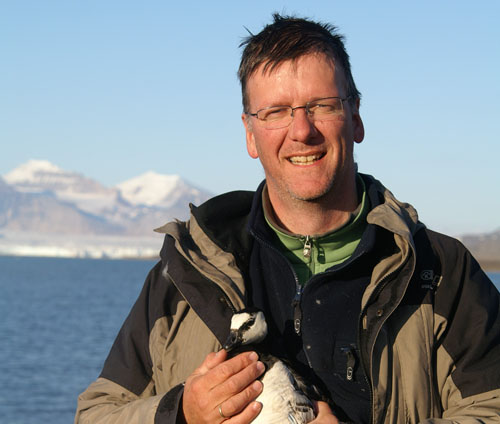
Biologiste • Pays-bas
Les oies seront-elles favorisées par le recul des glaces dans l’Arctique ou bien menacées par l’augmentation de prédateurs et de parasites ?
Maarten J.J.E. Loonen est biologiste au Centre Arctique de l’Université de Groningen aux Pays-Bas. Il a participé à plus de vingt campagnes d’été dans l’Arctique. Directeur de la base scientifique néerlandaise au Svalbard et expert scientifique à la commission de Conservation de la Flore et de la Faune Arctique (CAFF), il travaille à la protection de la biodiversité boréale. Ses recherches portent sur l’écologie terrestre arctique, tout particulièrement les oies arctiques.
As a student in biology, I got the opportunity to follow migrating geese to their summer grounds and discovered a place of immense beauty: the Arctic. My birds, the unique location and stimulating international cooperation in polar research made a combination with which I felt in love.
With the power of flight, birds are able to integrate resources over vast geographical areas. The geese fly to the Arctic following a green wave of nutritious spring grasses. The Arctic breeding grounds provide high quality food and a long period of daylight for grazing. The area is relatively safe from predators, hunters and diseases. Adult geese become flightless for a month, replacing their long flight feather and foraging with their young close to rivers and lakes.
I studied how well adapted goose behavior was. Shaped by evolution, the birds seemed highly intelligent, making decisions which we were able to model as optimal decisions.
But the environment changed. Goose populations increased rapidly as a result of human interference on the wintering grounds. Food quantity and quality improved, hunting pressure decreased and protection improved. On the summer grounds, the tundra became intensively grazed and grubbed with increasing competition among the individuals. Successful breeding became more difficult and only dominant individuals succeeded. However geese found new areas and population increase continued. Preferred food plants disappeared from the vegetation and only by building small fences which excluded geese, we were able to see how the tundra would look without geese.
In the past decades, we were unable to predict the magnitude of these changes. Now, while the Arctic is warming, it is impossible to predict the future. Will the geese profit from less snow and ice and increased plant growth or will they decline with more and new predators, parasites, diseases and human disturbance or lower food quality. Will the situation in the wintering grounds change with changing agricultural policies, fragmentation of the landscape or new competition with non-migrating geese which are rapidly increasing in western Europe.
We do observe changes in migration strategy, disturbance and food intake rate. More changes are inevitably. I hope to study these new adaptations and potential bottle necks to protect biodiversity of a typical Arctic ecosystem.
Maarten Loonen, Août 2010
Voir le site de la base scientifique néerlandaise au Svalbard : http://www.arcticstation.nl/

